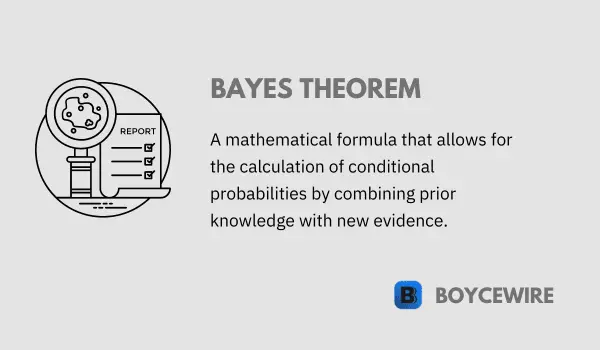Bayes Theorem: Definition, Formula & Examples

What is Bayes Theorem?
Bayes’ Theorem, named after the British mathematician Thomas Bayes, is a fundamental principle in the field of probability and statistics that describes how to update the probabilities of hypotheses when given evidence. It has wide-ranging applications, providing a mathematical framework for understanding how our beliefs about the world should rationally change as we gather more data.
In its simplest form, Bayes’ Theorem provides a way to reverse conditional probabilities. It allows us to update our initial beliefs about the occurrence of an event based on new evidence. In essence, Bayes’ Theorem is a method for refining predictions about the probability of an event based on the interplay between prior assumptions and new data.
Beyond its mathematical elegance, the real power of Bayes’ Theorem lies in its numerous applications. From medical diagnostics, machine learning, data science, and artificial intelligence, to weather prediction, financial modeling, code-breaking, and legal decision making, Bayes’ Theorem is an indispensable tool that aids in making educated probabilistic predictions based on limited information. Despite its origins in the 18th century, Bayes’ Theorem continues to be a foundational element in our data-driven world today.
Key Points
- Bayes’ theorem is a fundamental concept in probability theory that describes how to update or revise the probability of an event based on new information or evidence.
- Bayes’ theorem relates the conditional probability of an event A given an event B to the prior probability of event A and the conditional probability of event B given event A.
- Bayes’ theorem can be mathematically expressed as P(A|B) = [P(B|A) * P(A)] / P(B), where P(A|B) represents the probability of event A given event B, P(B|A) represents the probability of event B given event A, P(A) represents the prior probability of event A, and P(B) represents the prior probability of event B.
Understanding Bayes’ Theorem
Bayes’ Theorem is a principle in probability theory and statistics that calculates the conditional probability of an event. Conditional probability refers to the likelihood of an event occurring given that another event has already occurred. Essentially, it’s a method of updating predictions based on new data.
The mathematical formula for Bayes’ theorem is as follows:
P(A|B) = [P(B|A) * P(A)] / P(B)
Let’s break down this formula:
- P(A|B): This is the conditional probability of event A given that event B has occurred. It’s also known as the posterior probability, as it’s the revised probability of an event occurring after taking into account new information.
- P(B|A): This is the conditional probability of event B given that event A has occurred.
- P(A) and P(B): These are the probabilities of events A and B occurring independently. P(A) is also known as the prior probability, as it’s our initial belief before we have any additional information.
The theorem essentially says that the likelihood of event A occurring given that B has happened is equal to the likelihood of event B occurring given that A has happened, multiplied by the probability of A happening, and then divided by the probability of B happening.
The power of Bayes’ theorem comes from its ability to continuously update the probability of a hypothesis as more evidence or information becomes available. This process of updating our beliefs in light of new evidence reflects the iterative nature of learning and decision-making in a wide variety of fields, including data science, machine learning, medical diagnostics, finance, and more.
The Formula of Bayes’ Theorem
The core of Bayes’ theorem is a simple formula that allows us to update our beliefs or hypotheses based on new evidence. The formula for Bayes’ Theorem is:
P(A|B) = [P(B|A) * P(A)] / P(B)
Here is a detailed explanation of the elements of the formula:
- P(A|B): This is the conditional probability of event A given that event B has occurred. It is also referred to as the posterior probability because it represents our updated belief about event A after taking into account the evidence B.
- P(B|A): This is the conditional probability of event B given that event A has occurred. It is also referred to as the likelihood.
- P(A): This is the probability of event A occurring independently. It is also referred to as the prior probability because it represents our initial belief about event A before considering the evidence B.
- P(B): This is the probability of event B occurring independently. It serves as a normalization constant in the formula.
It is essential to understand that P(A|B) and P(B|A) are not the same. The conditional probability of A given B can be very different from the conditional probability of B given A, which is why the theorem is so useful for updating our beliefs when we receive new information.
In the context of hypothesis testing, for example, we could substitute the following:
- A for our hypothesis.
- B for the observed data.
- P(A|B) for the probability of our hypothesis being true given the observed data.
- P(B|A) for the probability of observing the data given that our hypothesis is true.
- P(A) for our initial assumption about the truth of our hypothesis.
- P(B) for the total probability of the observed data under all possible hypotheses.
By applying the formula, we can adjust our initial belief, P(A), based on the new evidence B, thereby obtaining an updated belief, P(A|B), about the validity of our hypothesis.
Examples of Bayes’ Theorem
To illustrate the application of Bayes’ Theorem, let’s consider a couple of examples.
Example 1: Medical Testing
Suppose a certain disease affects 1 in every 1,000 people in a population. A test for this disease is 99% accurate, meaning it returns a correct result 99% of the time.
If a randomly selected person tests positive, what’s the probability they actually have the disease? Bayes’ theorem can help answer this.
Here,
- A represents the event “person has the disease.”
- B represents the event “person tests positive.”
We know that:
- P(A) = 1/1000 (prior probability of having the disease)
- P(A’) = 999/1000 (prior probability of not having the disease)
- P(B|A) = 0.99 (probability of testing positive given the person has the disease)
- P(B|A’) = 0.01 (probability of testing positive given the person does not have the disease)
We want to find P(A|B), i.e., the probability of having the disease given the person tested positive. Using Bayes’ theorem:
P(A|B) = [P(B|A) * P(A)] / [P(B|A) * P(A) + P(B|A’) * P(A’)]
Substituting the known values:
P(A|B) = (0.99 * 0.001) / [(0.99 * 0.001) + (0.01 * 0.999)] ≈ 0.09 or 9%
So, even though the test is 99% accurate, a person who tests positive has only about a 9% chance of actually having the disease, highlighting the impact of the disease’s low prevalence.
Example 2: Spam Filter
A spam filter is a classic example of using Bayes’ theorem. Let’s consider a simple scenario: identifying spam emails based on the presence of the word “free”.
Suppose 2% of all emails are spam, and “free” appears in 50% of spam emails and in 10% of legitimate emails.
Here,
- A represents the event “email is spam.”
- B represents the event “email contains the word ‘free’.”
We know:
- P(A) = 0.02 (prior probability of an email being spam)
- P(A’) = 0.98 (prior probability of an email not being spam)
- P(B|A) = 0.5 (probability of ‘free’ beingin the email given it’s spam)
- P(B|A’) = 0.1 (probability of ‘free’ being in the email given it’s not spam)
We want to find P(A|B), i.e., the probability of an email being spam given it contains the word ‘free’. Using Bayes’ theorem:
P(A|B) = [P(B|A) * P(A)] / [P(B|A) * P(A) + P(B|A’) * P(A’)]
Substituting the known values:
P(A|B) = (0.5 * 0.02) / [(0.5 * 0.02) + (0.1 * 0.98)] ≈ 0.17 or 17%
So, if an email contains the word ‘free’, there’s about a 17% chance it’s spam based on these figures.
These examples illustrate the power of Bayes’ theorem to update our beliefs or predictions based on new evidence.
Limitations and Criticisms of Bayes’ Theorem
While Bayes’ theorem is an incredibly powerful tool in statistics and probability, it is not without its limitations and criticisms. These include:
- Subjectivity of Prior Probabilities: One of the most substantial criticisms of Bayes’ theorem is the use of prior probabilities (P(A) in our examples). In many cases, the prior is not known and must be estimated or chosen. This choice can be subjective and can heavily influence the outcome. If the prior is inaccurately assessed, it can lead to incorrect conclusions.
- Difficulty in Computing Posterior Distribution: When the model complexity increases or when we are dealing with multiple variables, it can become computationally intensive to calculate the posterior probabilities. This could lead to practical challenges in applying the theorem.
- Assumption of Independence: Bayes’ theorem assumes that the variables are independent of each other. However, this is not always the case in real-life scenarios. If the events are dependent, the application of Bayes’ theorem can yield incorrect results.
- Non-representative Data: The accuracy of Bayes’ theorem is heavily dependent on the representativeness of the data used. If the sample data does not accurately represent the population, then the posterior probability may be significantly off.
- The Problem of “Zero” Frequencies: When dealing with Bayesian probability in the context of frequency data, if a particular category or outcome has not yet been observed (i.e., it has a frequency of zero), then the estimated probability of that outcome can be zero. This is a problem because it essentially rules out the possibility of that outcome occurring in the future, which may not be accurate.
Despite these limitations, Bayes’ theorem remains a fundamental principle in statistics, widely used across diverse fields. Understanding its limitations helps in its appropriate application and interpretation of the results.
FAQs
Bayes’ theorem is a mathematical formula that describes how to update or revise the probability of an event based on new evidence or information.
Bayes’ theorem is named after Reverend Thomas Bayes, an English mathematician and Presbyterian minister, who first introduced the concept.
Bayes’ theorem is a fundamental concept in probability theory and has applications in various fields, including statistics, machine learning, medical diagnostics, and decision-making.
Bayes’ theorem calculates the probability of an event A given event B by combining the prior probability of event A, the conditional probability of event B given event A, and the prior probability of event B.
About Paul
Paul Boyce is an economics editor with over 10 years experience in the industry. Currently working as a consultant within the financial services sector, Paul is the CEO and chief editor of BoyceWire. He has written publications for FEE, the Mises Institute, and many others.

Further Reading
 Illusory Correlation: Definition & Examples - Illusory correlation occurs when we incorrectly believe that two variables have a relationship with each other. The connection between the…
Illusory Correlation: Definition & Examples - Illusory correlation occurs when we incorrectly believe that two variables have a relationship with each other. The connection between the…  Excise Tax: Definition, How it Works & Examples - An excise tax is a tax that is levied on specific products, usually in order to create a socially optimal…
Excise Tax: Definition, How it Works & Examples - An excise tax is a tax that is levied on specific products, usually in order to create a socially optimal…  Supply Chain Management: Definition, How it Works & Example - Supply chain management is the management of goods and services that a business needs to turn raw materials into the…
Supply Chain Management: Definition, How it Works & Example - Supply chain management is the management of goods and services that a business needs to turn raw materials into the… 
